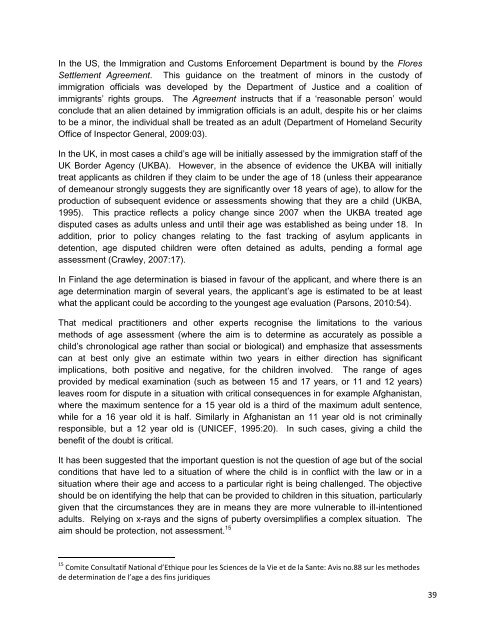Age assessment practices: a literature review & annotated ... - Unicef
Age assessment practices: a literature review & annotated ... - Unicef
Age assessment practices: a literature review & annotated ... - Unicef
You also want an ePaper? Increase the reach of your titles
YUMPU automatically turns print PDFs into web optimized ePapers that Google loves.
In the US, the Immigration and Customs Enforcement Department is bound by the Flores<br />
Settlement Agreement. This guidance on the treatment of minors in the custody of<br />
immigration officials was developed by the Department of Justice and a coalition of<br />
immigrants‟ rights groups. The Agreement instructs that if a „reasonable person‟ would<br />
conclude that an alien detained by immigration officials is an adult, despite his or her claims<br />
to be a minor, the individual shall be treated as an adult (Department of Homeland Security<br />
Office of Inspector General, 2009:03).<br />
In the UK, in most cases a child‟s age will be initially assessed by the immigration staff of the<br />
UK Border <strong>Age</strong>ncy (UKBA). However, in the absence of evidence the UKBA will initially<br />
treat applicants as children if they claim to be under the age of 18 (unless their appearance<br />
of demeanour strongly suggests they are significantly over 18 years of age), to allow for the<br />
production of subsequent evidence or <strong>assessment</strong>s showing that they are a child (UKBA,<br />
1995). This practice reflects a policy change since 2007 when the UKBA treated age<br />
disputed cases as adults unless and until their age was established as being under 18. In<br />
addition, prior to policy changes relating to the fast tracking of asylum applicants in<br />
detention, age disputed children were often detained as adults, pending a formal age<br />
<strong>assessment</strong> (Crawley, 2007:17).<br />
In Finland the age determination is biased in favour of the applicant, and where there is an<br />
age determination margin of several years, the applicant‟s age is estimated to be at least<br />
what the applicant could be according to the youngest age evaluation (Parsons, 2010:54).<br />
That medical practitioners and other experts recognise the limitations to the various<br />
methods of age <strong>assessment</strong> (where the aim is to determine as accurately as possible a<br />
child‟s chronological age rather than social or biological) and emphasize that <strong>assessment</strong>s<br />
can at best only give an estimate within two years in either direction has significant<br />
implications, both positive and negative, for the children involved. The range of ages<br />
provided by medical examination (such as between 15 and 17 years, or 11 and 12 years)<br />
leaves room for dispute in a situation with critical consequences in for example Afghanistan,<br />
where the maximum sentence for a 15 year old is a third of the maximum adult sentence,<br />
while for a 16 year old it is half. Similarly in Afghanistan an 11 year old is not criminally<br />
responsible, but a 12 year old is (UNICEF, 1995:20). In such cases, giving a child the<br />
benefit of the doubt is critical.<br />
It has been suggested that the important question is not the question of age but of the social<br />
conditions that have led to a situation of where the child is in conflict with the law or in a<br />
situation where their age and access to a particular right is being challenged. The objective<br />
should be on identifying the help that can be provided to children in this situation, particularly<br />
given that the circumstances they are in means they are more vulnerable to ill-intentioned<br />
adults. Relying on x-rays and the signs of puberty oversimplifies a complex situation. The<br />
aim should be protection, not <strong>assessment</strong>. 15<br />
15 Comite Consultatif National d’Ethique pour les Sciences de la Vie et de la Sante: Avis no.88 sur les methodes<br />
de determination de l’age a des fins juridiques<br />
39
















